The project of a nuclear powered submarine with a rocket engine (patent RU 2494004)
In March of this year, a patent was published under the number RU 2494004 with the laconic name "Nuclear Submarine". Despite the simplicity of the title, the document contains several overly bold ideas proposed for use in nuclear underwater navy. Inventors M.N. Bolotina, E.N. Nefedova, M.L. Nefedova and N.B. Bolotin offer the original design of the submarine, which will provide a marked increase in some characteristics, as well as give it a number of new features that are not yet available to modern submarines.
The proposed submarine described in the patent, has a non-standard layout of the type "trimaran". The main element of the boat is the central module of the traditional two-part design. Protection of the crew and units from water pressure is provided by a durable hull, over which a light hull is placed. The space between the two hulls is proposed to be filled with ballast tanks. In addition, a robust hull should be equipped with a solid wheelhouse that can hold a pop-up rescue chamber. In terms of overall layout and purpose, the central building is almost the same as the units used in modern submarines. Nevertheless, the new project offers a number of new non-standard solutions.
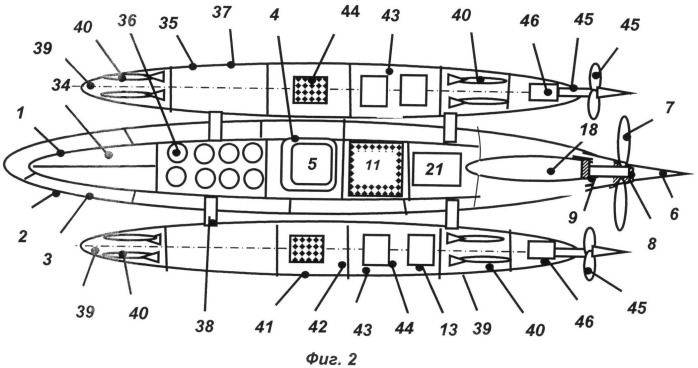
The general scheme of the proposed submarine, top view
On the sides of the central module, it is proposed to mount two so-called. torpedo module streamlined shape. According to the authors, torpedo modules represent a kind of central unit with a number of characteristic changes. Additional power plants and propellers should be placed in the side modules. Finally, a large streamlined jet engine cover should be located on top of the central module. Like the lateral "torpedo modules", a jet engine should be used to enhance the performance of a submarine.
Taking into account some features of existing submarine structures, the authors of the patent propose an original layout of a robust hull. Modern submarines have a single robust hull, divided into compartments sealed bulkheads. However, as noted by the inventors, this separation does not solve the problem of compartment separation, since there are many holes in the bulkheads for pipelines, cables, etc. Thus, in the event of an emergency, it is possible to spread it to the adjacent compartments through the existing technological openings.
To solve this problem, a nonstandard layout of a robust case is proposed that accommodates a power plant, weapons, control systems, residential compartments, etc. The main element of a durable hull of a promising submarine should be a special keel truss, on which other units should be installed. Instead of a single strong case, the inventors suggest using several relatively small capsules. In each such unit, this or that equipment should be located: a power plant, manned volume, weapons, etc. It is assumed that such an arrangement of robust hulls will allow to maintain the required characteristics of protection against external pressure, as well as to separate the compartments from each other, in particular to separate the crew and dangerous parts of the nuclear reactor. In this case, the capsules should not be completely separated. For communication between them, it is proposed to use sealed hatches and locks.
One of the capsules of the proposed submarine must perform several functions aimed at ensuring the control of the submarine and the rescue of the crew. It is proposed to place the central post and all the equipment management systems. The capsule with the central post should also perform the functions of a rescue chamber. If necessary, it must be separated, saving the entire crew. To more effectively accomplish the task of rescuing people, the camera should be performed as a full-fledged mini-submarine.
Another original proposal concerns the methods of power supply of the submarine. So, instead of a set of diesel generators and a large large-capacity battery, it is proposed to use thermoelectric generators. The power of these units associated with a nuclear reactor, according to the inventors, should be selected in accordance with the parameters of the main engine and other onboard systems.
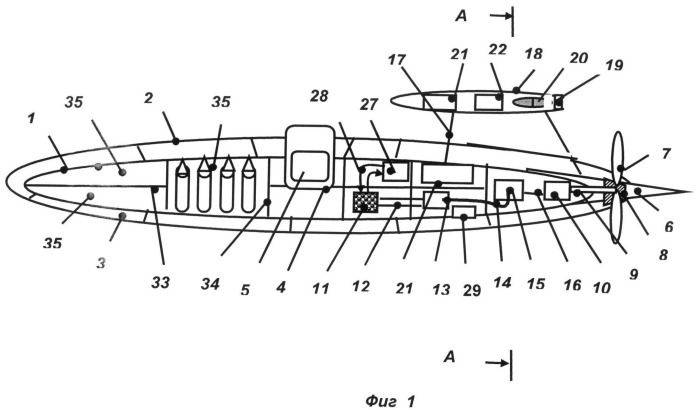
Central module diagram, side view
Control of the onboard systems of the prospective submarine should be carried out using remote control systems. This feature of the project, in particular, can significantly reduce the size of the crew. According to the calculations of the authors of the invention, to ensure a three-shift watch, no more than 15 people should be present in the crew. Their task is to monitor the operation of the systems and control them using automated tools. Auxiliary tasks such as food, cleaning, medical assistance, etc. should be performed under the shift shift. As evidence of the effectiveness of this approach, the inventors cite the experience of astronauts.
For additional protection of the propeller and steering units, as well as for solving a number of existing problems, the inventors propose the original design of the propeller shaft and other units of the power plant. In the existing projects of the submarines, the aft of the hull is narrowed, which reduces the volumes available for the installation of various equipment. In the patent RU 2494004, it is proposed to use a non-standard propeller hub design that does not require tapering of the hull.
For this purpose, a gap is provided in the aft section of the light hull, in which the screw hub is located. The latter, in turn, rests on the design of a durable case and must move along special support surfaces with an anti-friction coating. Such a unit is proposed to be cooled using seawater.
Due to the increase in hub diameter, a new propeller design is required. It is proposed to equip a large number of blades of reduced height. As the inventors believe, this design will provide the required craving even at super-low revs.
It is proposed to carry out the rotation of the propeller due to several electric motors installed radially inside the robust hull. On the output shafts of the engines it is proposed to place gears that engage with the gear wheel inside the propeller hub.
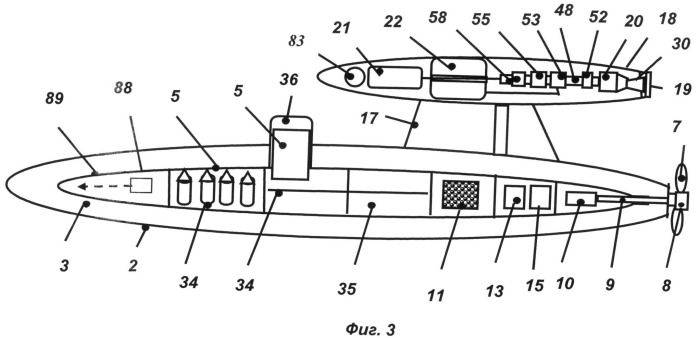
Another variant of the central module diagram
The side torpedo modules are double-hulled units with their own nuclear reactors and other elements of the power plant. In addition, the modules are equipped with their own propellers of the same design as in the case of the central module of the submarine. In the bow of the torpedo modules are automated compartments with weapons. Own armament of side modules should consist of several torpedo tubes with a stock of torpedoes. As in the case of other systems, weapons must be remotely controlled from a central location.
Torpedo modules, according to the inventors, should be connected to the central submarine module using quick-release fasteners. In particular, pyrobolts can be used for this. If necessary, the crew should be able to reset the modules and continue the task without them.
One of the most interesting proposals of the inventors relates to an additional power plant. The team of authors proposes to equip a promising nuclear submarine with not only three propellers with electric motors, but also a liquid rocket engine. Such a unit, not at all typical of old, modern or prospective submarines, should have a positive effect on the characteristics of the submarine.
On the upper part of the stern of the central building, it is proposed to mount a pylon with a large casing of the rocket power plant. To protect the units, the nozzle can be covered with a drop cap. Inside the casing there should be a power frame, an engine with a combustion chamber and a nozzle, a gas generator, a turbo pump unit and other components of the fluid engine. In addition, the project provides for the use of thrust vector control systems in two planes.
To control thrust vectoring, the engine must swing in horizontal and vertical planes, providing direction and trim control. Any roll control systems in the engine design are not provided. Apparently, such management is proposed to be carried out using the rudders on the boat hull.
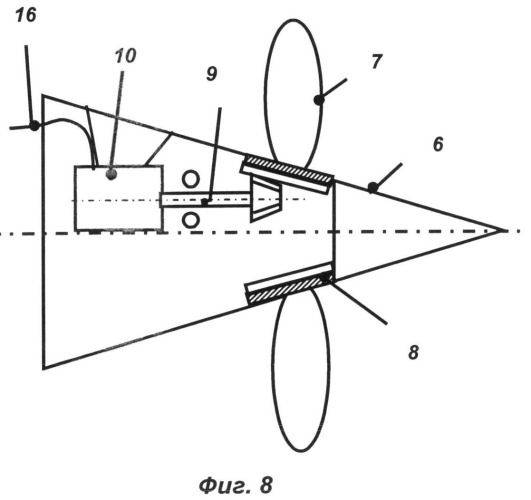
The original layout of the propeller
Patent RU 2494004 proposes an original way to supply the engine with fuel. In order to abandon the tanks for the transport of fuel and oxidizer, you can use the engine running on a mixture of hydrogen and oxygen. Such fuel can be obtained from seawater by electrolysis. In view of the presence of a nuclear reactor on a submarine, this method of extracting fuel is considered optimal. As a result, the submarine, as conceived by the authors, can remain under water for a long time, using a rocket engine that runs on independently produced fuel, if necessary.
A promising nuclear submarine with a rocket engine can carry torpedo and rocket weapons. Torpedo tubes and their ammunition are planned to be placed in the side torpedo modules. The missile launchers, in turn, must be located in one of the nasal capsules of the robust case of the central module. The inventors believe that a similar submarine can carry various types of missiles, both anti-ship and designed to attack targets at ranges up to 3-5 thousand km.
Submarine custom design must have the appropriate tactics of combat use. Indeed, the patent RU 2494004 proposes an extraordinary way of conducting attacks. According to the authors of the invention, a promising submarine should be able to accelerate to high speeds. So, when ascending to the surface and turning on a jet engine, it should reach a speed of the order of M = 0,5 ... 1. In this case, the submarine is virtually invulnerable to enemy attacks.
Having sped up to high speed, the submarine must make an attack using torpedoes or rockets. It is noted that due to the high speed of the boat at the time of launching, opposition to launched torpedoes becomes impossible. Also, while on high speed, the submarine can launch rockets. Due to the use of various weapons it is possible to solve operational-tactical or strategic tasks. After completing the attack, the submarine should return to depth.
The use of an additional booster rocket engine allows you to carry out sudden transient attacks, as well as leave the area where the target is located. In particular, in the event of the discovery of such a submarine will be able in the shortest possible time to move a considerable distance from the enemy and then go under water. Thus, by the time of arrival in the area of detection of anti-submarine ships or enemy aircraft, the promising submarine will be at a safe distance from it.
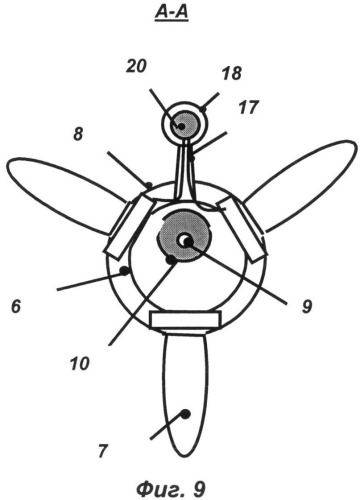
Power plant, propeller and jet engine
The inventors believe that in the proposed project they were able to successfully solve a number of important tasks. First: ensuring a short-term significant increase in the speed of the dol level M = 0,5 ... 1. When using this opportunity during a torpedo or rocket attack, it is possible to effectively defeat the target, while the boat itself is almost completely invulnerable to enemy defenses.
The second task: thrust vector control. Due to several original ideas, the proposed liquid rocket engine can be used for control in two planes. Due to the swing of the combustion chamber and the nozzle is proposed to control the trim and direction.
The third success, according to the inventors, concerns the safety of the crew. Being in a separate capsule and controlling all systems remotely, submariners do not risk anything. In addition, the rescue of the crew in an emergency situation is ensured by a detachable chamber, regularly performing the functions of the central post. In addition, there are no fuel tanks in the habitable capsule, which should increase the safety of the crew.
As part of the power plant of the proposed submarine, there are three independent modules. Each of them has its own nuclear reactor and a number of other equipment. In addition, all three main modules of the submarine are equipped with their own propellers of the original design, connected to a set of electric motors. All this, according to the inventors, should provide the possibility of long-term autonomous navigation.
This same design feature is the solution to the fifth task of the project. Three autonomous power plants make it possible to achieve high reliability of the design. In the event of failure of one of the installations, the submarine maintains progress and can continue to perform the assigned combat mission.
Finally, the modular construction of the structure allows, if necessary, the use of a promising submarine for non-military purposes. To do this, you should dismantle the side torpedo modules and change the equipment of some capsules used for military purposes.
***
The proposal of inventors M.N. Bolotina, E.N. Nefedova, M.L. Nefedova and NB Bolot is of interest, at least, as a curious technical curiosity. Their invention is so unusual and difficult that it is possible to judge its prospects even without detailed study. Moreover, even with a superficial examination, it can be noted that the proposed project has technical, operational and tactical problems. As a result, it is unlikely that it will be able to find use in the medium term or even in the distant future.
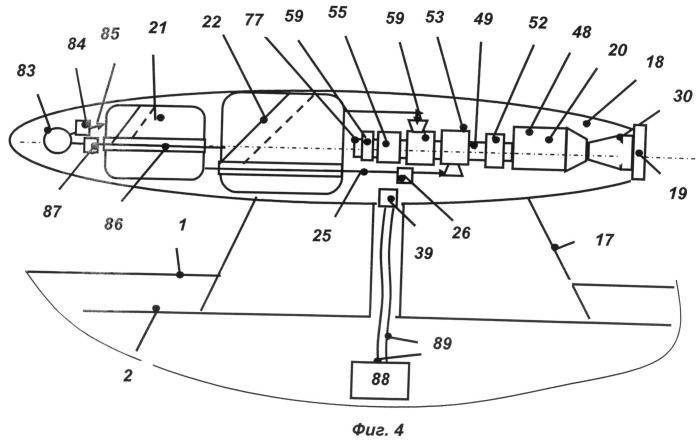
Scheme additional power plant with a jet engine
Nevertheless, it should be noted that some sentences look sensible and are already being used in practice in one form or another. Thus, domestic designers have already used the idea of dividing a single cylindrical solid compartment into several separate units of a different shape. Thus, the special submarine (nuclear deep-water station) АС-12 of the 210 project “Losharik”, according to some data, has a solid hull, assembled from several spherical compartments. Such an arrangement made it possible to increase the strength of the hull and, as a result, the maximum depth of immersion.
Other ideas can not be considered realizable or suitable for practical use. For example, the idea of complete control of all systems from a central location, although it looks promising and attractive, is associated with a lot of difficulties. This requires a lot of automated systems, however, in this case, it is unlikely that it will be possible to reduce human participation to the required level or to eliminate the need for submariners to stay outside the designated habitable compartment.
Also, the minus of the proposal can be considered a specific layout with a central module and two torpedo tubes connected to it. Such a design can hardly be considered optimal from the point of view of hydrodynamics. It will face increased water resistance, which will adversely affect a number of key features, especially speed and power consumption.
Such design features, in particular, may make it difficult or even impossible to achieve the planned speed characteristics. As conceived by the inventors, a promising submarine in a surface position should reach speed at the level of the speed of sound (probably, there is a speed of sound in the air, not in the water). However, due to the large area of the wetted surface, the design of the submarine has to face high water resistance, which will call into question the possibility of acceleration even to 50-100 km / h, not to mention higher speeds.
The patent proposes to equip the submarine with an additional jet engine. Such an idea does not look too plausible, primarily due to the fact that, due to various reasons, rocket engines have not yet found application in the submarine fleet as the main propulsion for submarines. Moreover, there is reason to doubt that they will generally be used in this area. Thus, while jet submarines remain only in science fiction. Thus, the submarine "Pioneer" from the book by G. Adamov "The Mystery of the Two Oceans" was equipped with a jet engine working on a mixture of hydrogen and oxygen.
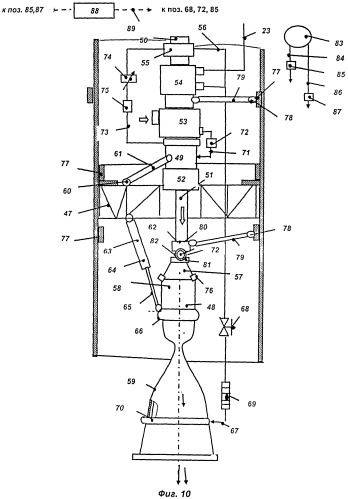
Scheme of the rocket engine and its control systems
Even if one imagines that the submarine can really be equipped with a jet engine, such equipment will definitely face a number of serious problems. It is not difficult to guess that a large casing of such a power plant, located above the central hull, will necessarily lead to a deterioration of the already not the best streamlined. Thus, the engine can only be useful during a high-speed attack, while at other times it will only interfere with and degrade performance.
The proposal to attack targets from a surface position with acceleration to maximum speed also looks doubtful. The main "trump card" of submarines is their secrecy, which allows them to quietly take an advantageous position to attack and fire torpedoes or missiles. Ascent to the surface and acceleration to subsonic speed does not fit into the classical method of using submarines. Moreover, such proposals directly contradict it.
In addition, in this case a fair question arises: if the proposed submarine should attack the enemy in a surface position, then why does she even need the ability to move at depth? You can also ask a second question: why rise to the surface and accelerate, if you can just as well destroy a target by attacking from the depths? These questions do not have normal answers that correspond to the classic tactics of using submarines of various classes. In addition, it is doubtful that these questions in general may have any logical and understandable answers.
As you can see, the original nuclear submarine, which is the subject of the patent RU 2494004, has a lot of original and unusual features that attract attention, but close the project to the road to implementation. On closer examination, the proposal of inventors M.N. Bolotina, E.N. Nefedova, M.L. Nefedova and NB Bolotin turns out to be another promising search project with no clear prospects.
Such inventions appear with enviable regularity and often become the subject of patents. However, they never reach the stage of practical application. The complexity, lack of thought and other negative features ultimately affect the future fate of the proposals, because of which they remain on paper and can not be anything more than a reason for pride of the creator. On the other hand, despite the dubious prospects, such things are of particular interest. They perfectly demonstrate the tricks the human mind is capable of in creating new ideas.
On the materials of the sites:
http://findpatent.ru/
http://russianpatents.com/
http://raigap.livejournal.com/
Patent RU 2494004:
http://findpatent.ru/patent/249/2494004.html
Information